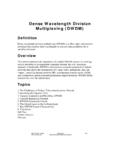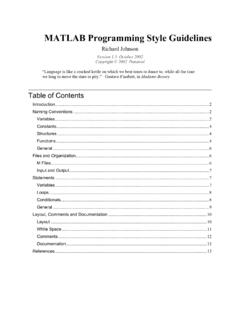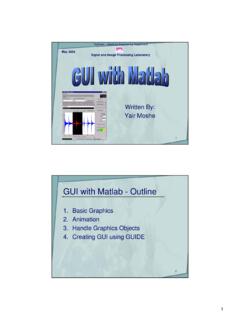Transcription of Tcl Basics - Columbia University
1 1 PARTI. Tcl Basics ITcl BasicsPart I introduces the Basics of Tcl. Everyone should read Chapter 1, whichdescribes the fundamental properties of the language. Tcl is really quite simple,so beginners can pick it up quickly. The experienced programmer should reviewChapter 1 to eliminate any misconceptions that come from using other 2 is a short introduction to running Tcl and Tk on UNIX, Windows,and Macintosh systems. You may want to look at this chapter first so you can tryout the examples as you read Chapter 3 presents a sample application, a CGI script, that implements aguestbook for a Web site. The example uses several facilities that are describedin detail in later chapters. The goal is to provide a working example that illus-trates the power of rest of Part I covers basic programming with Tcl.
2 Simple string pro-cessing is covered in Chapter 4. Tcl lists, which share the syntax rules of Tcl com-mands, are explained in Chapter 5. Control structure like loops and ifstatements are described in Chapter 6. Chapter 7 describes Tcl procedures,which are new commands that you write in Tcl. Chapter 8 discusses Tcl are the most flexible and useful data structure in Tcl. Chapter 9 describesfile I/O and running other programs. These facilities let you build Tcl scripts thatglue together other programs and process data in reading Part I you will know enough Tcl to read and understand otherTcl programs, and to write simple programs yourself. Blankpage 23 CHAPTERI. Tcl Basics 1 Tcl Fundamentals1 This chapter describes the basic syntax rules for the Tcl scripting language.
3 Itdescribes the basic mechanisms used by the Tcl interpreter: substitutionand grouping. It touches lightly on the following Tcl commands: puts,format, set, expr, string, while, incr, and is a string-based command lan-guage. The language has only a few fundamental constructs and relatively littlesyntax, which makes it easy to learn. The Tcl syntax is meant to be simple. Tcl isdesigned to be a glue that assembles software building blocks into simpler glue makes the job easier. In addition, Tcl is interpreted when theapplication runs. The interpreter makes it easy to build and refine your applica-tion in an interactive manner. A great way to learn Tcl is to try out commandsinteractively. If you are not sure how to run Tcl on your system, see Chapter 2 forinstructions for starting Tcl on UNIX, Windows, and Macintosh chapter takes you through the Basics of the Tcl language syntax.
4 Evenif you are an expert programmer, it is worth taking the time to read these fewpages to make sure you understand the fundamentals of Tcl. The basic mecha-nisms are all related to strings and string substitutions, so it is fairly easy tovisualize what is going on in the interpreter. The model is a little different fromsome other programming languages with which you may already be familiar, soit is worth making sure you understand the basic CommandsTcl stands for Tool Command Language. A command does something for you, likeoutput a string, compute a math expression, or display a widget on the casts everything into the mold of a command, even programming constructs4 Tcl Fundamentals Chap. 1like variable assignment and procedure definition.
5 Tcl adds a tiny amount ofsyntax needed to properly invoke commands, and then it leaves all the hard workup to the command basic syntax for a Tcl command is:command arg1 arg2 arg3 ..The command is either the name of a built-in command or a Tcl space ( , spaces or tabs) is used to separate the command name and itsarguments, and a newline ( , the end of line character ) or semicolon is used toterminate a command. Tcl does not interpret the arguments to the commandsexcept to perform grouping, which allows multiple words in one argument, andsubstitution, which is used with programming variables and nested commandcalls. The behavior of the Tcl command processor can be summarized in threebasic steps: Argument grouping.
6 Value substitution of nested commands, variables, and backslash escapes. Command invocation. It is up to the command to interpret its arguments. This model is described in detail in this , World!Example 1 1 The Hello, World! stdout {Hello, World!}=> Hello, World!In this example, the command is puts, which takes two arguments: an I/Ostream identifier and a string. puts writes the string to the I/O stream alongwith a trailing newline character . There are two points to emphasize: Arguments are interpreted by the command. In the example, stdout is usedto identify the standard output stream. The use of stdout as a name is aconvention employed by puts and the other I/O commands. Also, stderr isused to identify the standard error output, and stdin is used to identify thestandard input.
7 Chapter 9 describes how to open other files for I/O. Curly braces are used to group words together into a single argument. Theputs command receives Hello, World! as its second argument. The braces are not part of the braces are syntax for the interpreter, and they get stripped off beforethe value is passed to the command. Braces group all characters, including new-lines and nested braces, until a matching brace is found. Tcl also uses doublequotes for grouping. Grouping arguments will be described in more detail Tcl BasicsVariablesThe set command is used to assign a value to a variable. It takes two arguments:The first is the name of the variable, and the second is the value. Variable namescan be any length, and case is significant.
8 In fact, you can use any character in avariable is not necessary to declare Tcl variables before you use them. The interpreter will create the variable when it is first assigned a value of a variable is obtained later with the dollar-sign syntax, illustratedin Example 1 2:Example 1 2 Tcl var 5=> 5set b $var=> 5 The second set command assigns to variable b the value of variable use of the dollar sign is our first example of substitution. You can imaginethat the second set command gets rewritten by substituting the value of var for$var to obtain a new b 5 The actual implementation of substitution is more efficient, which is importantwhen the value is SubstitutionThe second form of substitution is command substitution.
9 A nested command isdelimited by square brackets, [ ]. The Tcl interpreter takes everything betweenthe brackets and evaluates it as a command. It rewrites the outer command byreplacing the square brackets and everything between them with the result ofthe nested command. This is similar to the use of backquotes in other shells,except that it has the additional advantage of supporting arbitrary nesting 1 3 Command len [string length foobar]=> 6In Example 1 3, the nested command is:string length foobarThis command returns the length of the string foobar. The string com-mand is described in detail starting on page 45. The nested command runs Tcl Fundamentals Chap. 1 Then, command substitution causes the outer command to be rewritten as if itwere:set len 6If there are several cases of command substitution within a single com-mand, the interpreter processes them from left to right.
10 As each right bracket isencountered, the command it delimits is evaluated. This results in a sensibleordering in which nested commands are evaluated first so that their result canbe used in arguments to the outer ExpressionsThe Tcl interpreter itself does not evaluate math expressions. Tcl just doesgrouping, substitutions and command invocations. The expr command is used toparse and evaluate math expressions. Example 1 4 Simple / 4=> math syntax supported by expr is the same as the C expression expr command deals with integer, floating point, and boolean values. Logicaloperations return either 0 (false) or 1 (true). Integer values are promoted to float-ing point values as needed. Octal values are indicated by a leading zero ( , 033is 27 decimal).











